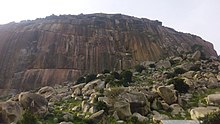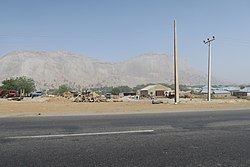|
Zamfara State
 Zamfara (Hausa: Jihar Zamfara; Fula: Leydi Zamfara; Adlam: 𞤤𞤫𞤴𞤣𞤭 𞤶𞤢𞤥𞤬𞤢𞤪𞤢) is a state in northwestern Nigeria. The capital of Zamfara state is Gusau and its current governor is Dauda Lawal. Until 1996, the area was part of Sokoto State. Zamfara is a densely populated area with the Hausa. The Zamfarawa mainly in Anka, Gummi, Bukkuyum and Talata Mafara Local Governments areas. Gobirawa populated Shinkafi Local Government.[4] Gobirawa actually migrated from the Gobir Kingdom. Burmawa are found in Bakura and Fulani peopled Bungudu, Maradun, Gusau and are scattered all over the State. In Chafe, Bungudu and Maru, most are mainly Katsinawa, Garewatawa and Hadejawa. While, Alibawa people are located at Kaura Namoda and Zurmi, the Alawan Shehu Usmanu Fulani's are found in Birninmagaji.[5] It is bordered to the north by the Republic of the Niger for 32 km (20 miles), to the south by Kaduna State for 117 km (73 miles) and Niger for 38 km (24 miles), to the east by Katsina State, and to the west by the states of Sokoto and Kebbi. It has a population of 3,278,873 according to the 2006 census and contains fourteen local government areas. History The people of Zamfara have over the years struggled for autonomy, but it was not until 1996 that the then military administration of the late General Sani Abacha detached the Zamfara State from Sokoto State with an area of 38,418 square kilometres. The first Governor was Jibril Yakubu.[5][failed verification] The area today called Zamfara state was one of the old Hausa Kingdoms like Kano, Katsina, Gobir, Kabi and Zazzau. The earliest inhabitants of Zamfara were said to have been hunters and giants.[6] They established their first settlement at Dutsi, which was the first capital of Zamfara. It extends up to the bend of River Rima to the north west and River Ka in the south west. Zamfara Kingdom was established in the 11th century and flourished up to 16th century as a city-state. Its capital has shifted with the fortunes of the kingdom from place to place like Dutsi and Birnin Zamfara. In the first half of the 18th century, its then capital Birnin Zamfara, was destroyed by the Gobir Kingdom and a new capital was established in Anka by the second half of the 19th century. Zamfara had many centres of commerce and scholarship that attracted many scholars like the Yandoto city. It became part of the Sokoto Caliphate after the 1804 jihad by Usman dan Fodio. In fact, Usman Danfodiyo settled in Sabon Gari where Sarkin Zamfara Abarshi had already established a garrison headquarters during the early days of his Jihad as a base from where he fought Gobir and Kabi.[7] At the wake of British colonialism, the emerging town of Gusau became an important commercial and administrative centre with road and rail networks passing through it. With the creation of states during the Gowon Administration, Zamfara Kingdom became part of the then North West state and later the Sokoto State.[7] GeographyClimateThe climate condition of Zamfara is tropical with temperatures rising up to 38 °C (100.4 °F) and above between March and May. Rainy season starts in late May to September while the mild season known as Harmattan lasts from December to April. The hottest months in Zamfara are March and April, and that is just before the first rains. the onset of the rains bring a cooling effect with temperature dropping.[8] PollutionSignificant health risks are posed by dust and particulate matter in Zamfara, especially to the deepest parts of the lungs, where they may exacerbate lungs diseases like bronchitis and asthma attacks while weakening the body defences against infections.[9][10][11] Local Government AreasZamfara State consists of fourteen (14) Local Government Areas. They are: Demographics Zamfara State is mainly populated by Hausa.[12] The state capital is an important commercial centre with a heterogeneous population of people from all over Nigeria. As in all major towns in Nigeria, all the major towns in Zamfara have a large population of other peoples from different parts of Nigeria.[5] HausaThis is one of the official languages of the state. English is spoken by the zamfara state government as an official language and Arabic language is spoken by the Muslim ummah and Islamic clerics. Economy  Agriculture and gold mining are the state's main occupations and the central source of income. Irrigation is required for cereals and legumes, hence the slogan "farming is our pride".[14] Over 80 percent of the population is engaged in agriculture. Major products include millet, guinea corn, maize, rice, groundnut, cotton, tobacco and beans.[15] The State is known as farming is our pride because Agriculture provides foodstuffs, raw materials and employment opportunities for young people in the State.[5] The state is one of the poorest in Nigeria and has one of the highest incidences of extreme poverty (over 60% of the population) according to World Bank data from 2018.[16] Natural resourcesZamfara state has many natural resources, some are:[17] EducationTertiary institutions in Zamfara state include:
Healthcare Zamfara state has many healthcare centres and hospitals, some of them are:
TransportFederal HighwaysA126 northwest from Katsina State near Kutcheri as the Gusau Rd via Tsafe, Unguwar Audu, Gusau, Bungundu, Kabai, and Talata Mafara to Sokoto State at Bimasa as the Sokoto-Gusau Rd. Other major roads
RailwaysGusau is connected with the 1067 mm Cape Gauge Western Line by the 245 km Zaria-Kaura Namoda branch line. AirportsIncidentsIn 2009, gold mining became a greater source of income in Zamfara State as worldwide gold prices rose drastically.[24] High concentrations of Lead in the ore from which gold was being extracted led to a Lead poisoning outbreak in the state, requiring national and international intervention to remediate affected areas and provide medical care to children with severe Lead poisoning.[4] Bandit attacksZamfara is known to experience several recent attacks from bandits. Some among them are: On 26 February 2021, 279 girls were abducted from their boarding school located in Jangebe, Zamfara during the Zamfara kidnapping. They have since been released.[25] On 11–12 June 2021, motorcycle-riding bandits killed over 53 villagers, mostly farmers.[26] On 4–6 January 2022, over 200 people were killed by bandits in Zamfara State.[27][28] ReligionIslam is the principal and major religion of the state. Christianity also has many adherents. The original native religions also remain but they have the fewest followers. These religions are mainly practiced in ancient settlements like Dutsi and Kwatarkwashi. Zamfara was the first state in Nigeria to introduce Sharia law during the tenure of Ahmad Sani Yerima, the former Governor of the state. Tourism Zamfara State holds some number of tourist attractions which are of historical or religious importance. These include Jata, an ancient settlement of Zamfara located around the hill with a large cave around where traditional practices were performed.[15] Notable people
PoliticsThe state government is led by a democratically elected governor who works closely with members of the state house of assembly. The capital city of the state is Gusau.[citation needed] See alsoReferences
External linksWikimedia Commons has media related to Zamfara State. |
||||||||||||||||||||||||||||||||||||||||||||||||||||||||||||||||||||||




